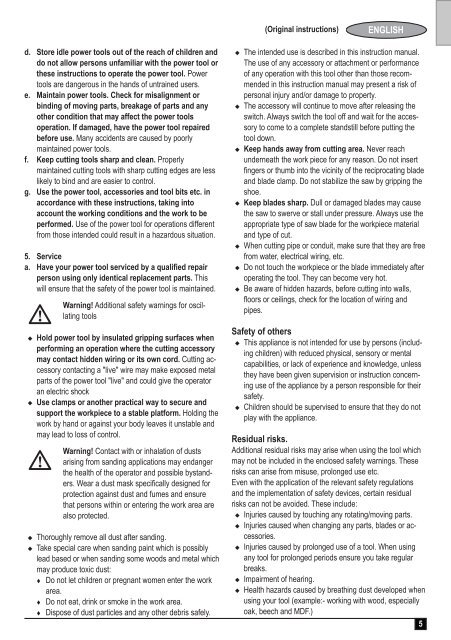BlackandDecker Utensile Multifunzione- Mt250 - Type 1 - Instruction Manual (Inglese)
BlackandDecker Utensile Multifunzione- Mt250 - Type 1 - Instruction Manual (Inglese)
BlackandDecker Utensile Multifunzione- Mt250 - Type 1 - Instruction Manual (Inglese)
You also want an ePaper? Increase the reach of your titles
YUMPU automatically turns print PDFs into web optimized ePapers that Google loves.
(Original instructions)<br />
ENGLISH<br />
d. Store idle power tools out of the reach of children and<br />
do not allow persons unfamiliar with the power tool or<br />
these instructions to operate the power tool. Power<br />
tools are dangerous in the hands of untrained users.<br />
e. Maintain power tools. Check for misalignment or<br />
binding of moving parts, breakage of parts and any<br />
other condition that may affect the power tools<br />
operation. If damaged, have the power tool repaired<br />
before use. Many accidents are caused by poorly<br />
maintained power tools.<br />
f. Keep cutting tools sharp and clean. Properly<br />
maintained cutting tools with sharp cutting edges are less<br />
likely to bind and are easier to control.<br />
g. Use the power tool, accessories and tool bits etc. in<br />
accordance with these instructions, taking into<br />
account the working conditions and the work to be<br />
performed. Use of the power tool for operations different<br />
from those intended could result in a hazardous situation.<br />
5. Service<br />
a. Have your power tool serviced by a qualified repair<br />
person using only identical replacement parts. This<br />
will ensure that the safety of the power tool is maintained.<br />
@<br />
Warning! Additional safety warnings for oscillating<br />
tools<br />
u Hold power tool by insulated gripping surfaces when<br />
performing an operation where the cutting accessory<br />
may contact hidden wiring or its own cord. Cutting accessory<br />
contacting a "live" wire may make exposed metal<br />
parts of the power tool "live" and could give the operator<br />
an electric shock<br />
u Use clamps or another practical way to secure and<br />
support the workpiece to a stable platform. Holding the<br />
work by hand or against your body leaves it unstable and<br />
may lead to loss of control.<br />
@<br />
Warning! Contact with or inhalation of dusts<br />
arising from sanding applications may endanger<br />
the health of the operator and possible bystanders.<br />
Wear a dust mask specifically designed for<br />
protection against dust and fumes and ensure<br />
that persons within or entering the work area are<br />
also protected.<br />
u Thoroughly remove all dust after sanding.<br />
u Take special care when sanding paint which is possibly<br />
lead based or when sanding some woods and metal which<br />
may produce toxic dust:<br />
t Do not let children or pregnant women enter the work<br />
area.<br />
t Do not eat, drink or smoke in the work area.<br />
t Dispose of dust particles and any other debris safely.<br />
u The intended use is described in this instruction manual.<br />
The use of any accessory or attachment or performance<br />
of any operation with this tool other than those recommended<br />
in this instruction manual may present a risk of<br />
personal injury and/or damage to property.<br />
u The accessory will continue to move after releasing the<br />
switch. Always switch the tool off and wait for the accessory<br />
to come to a complete standstill before putting the<br />
tool down.<br />
u Keep hands away from cutting area. Never reach<br />
underneath the work piece for any reason. Do not insert<br />
fingers or thumb into the vicinity of the reciprocating blade<br />
and blade clamp. Do not stabilize the saw by gripping the<br />
shoe.<br />
u Keep blades sharp. Dull or damaged blades may cause<br />
the saw to swerve or stall under pressure. Always use the<br />
appropriate type of saw blade for the workpiece material<br />
and type of cut.<br />
u When cutting pipe or conduit, make sure that they are free<br />
from water, electrical wiring, etc.<br />
u Do not touch the workpiece or the blade immediately after<br />
operating the tool. They can become very hot.<br />
u Be aware of hidden hazards, before cutting into walls,<br />
floors or ceilings, check for the location of wiring and<br />
pipes.<br />
Safety of others<br />
u This appliance is not intended for use by persons (including<br />
children) with reduced physical, sensory or mental<br />
capabilities, or lack of experience and knowledge, unless<br />
they have been given supervision or instruction concerning<br />
use of the appliance by a person responsible for their<br />
safety.<br />
u Children should be supervised to ensure that they do not<br />
play with the appliance.<br />
Residual risks.<br />
Additional residual risks may arise when using the tool which<br />
may not be included in the enclosed safety warnings. These<br />
risks can arise from misuse, prolonged use etc.<br />
Even with the application of the relevant safety regulations<br />
and the implementation of safety devices, certain residual<br />
risks can not be avoided. These include:<br />
u Injuries caused by touching any rotating/moving parts.<br />
u Injuries caused when changing any parts, blades or accessories.<br />
u Injuries caused by prolonged use of a tool. When using<br />
any tool for prolonged periods ensure you take regular<br />
breaks.<br />
u Impairment of hearing.<br />
u Health hazards caused by breathing dust developed when<br />
using your tool (example:- working with wood, especially<br />
oak, beech and MDF.)<br />
5
















